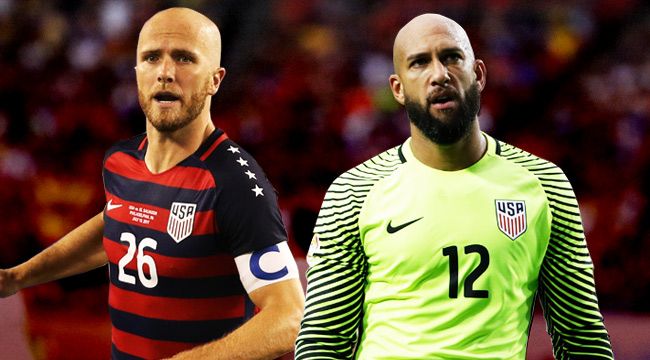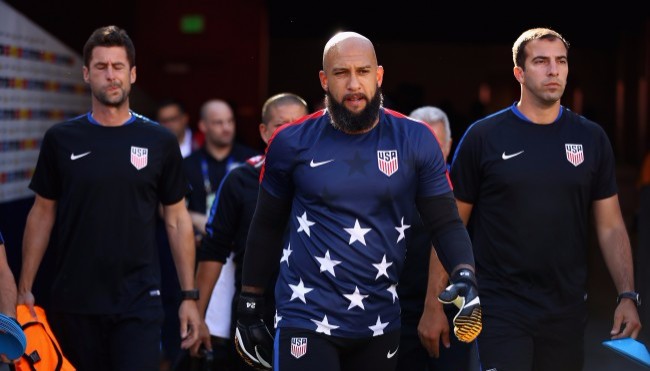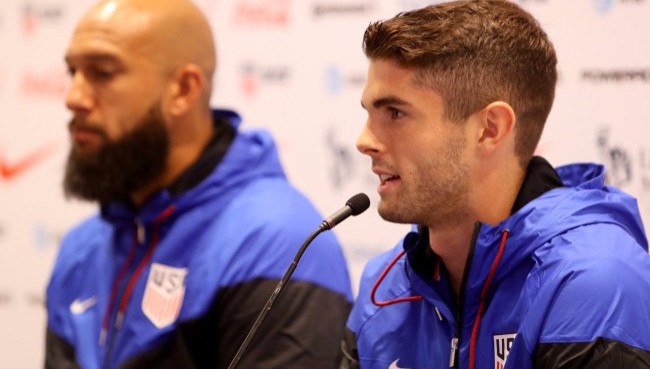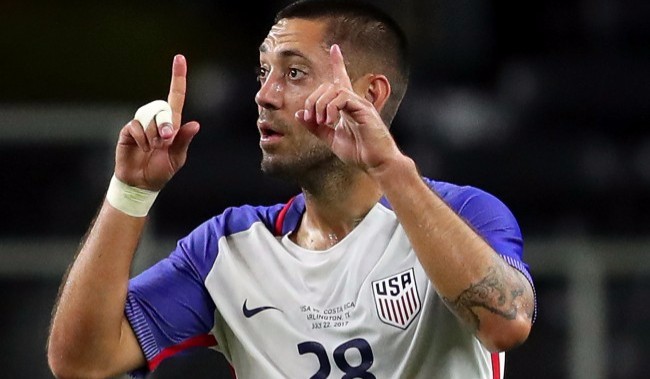
The United States Men’s National Soccer Team has not taken the pitch since winning the Gold Cup in July. It was a nice moment to cap off what has been a pretty solid stretch for the Americans, who have not lost since last November. But despite that moment, something far more important has been on the horizon for some time: The return of World Cup qualifying.
The U.S. is currently in the midst of a battle to make it to the 2018 World Cup in Russia. It should make it there, but a ton is riding on their results in a pair of qualifiers that take place over the next week. Haven’t been following along? No worries. We made a brief explainer to get you all caught up on what the USMNT has going on, what the best and worst case scenarios are, and why these upcoming matches highlight an American who has the potential to become an international soccer star.
What is the United States doing right now?
We are currently in the final round of 2018 World Cup qualifiers for CONCACAF, the Confederation of North, Central American and Caribbean Association Football. There are five rounds, they began in March of 2015, and are a gigantic slog that should end with the United States securing a spot in the World Cup.
At this stage — called “The Hex” because six teams make it — you play every team twice, once at home, once on the road. You get three points for a win, one point for a draw, and zero points for a loss. Currently, the Americans sit in third with eight points. Mexico is on top with 14, Costa Rica is in second with 11, Panama is in fourth with seven, then Honduras and Trinidad and Tobago round out the group with five and three points, respectively.
Each club has four matches left. There are qualifiers over the next week and then two more in Early October. At that point, the United States will finish in the top-3 and earn an automatic spot to Russia in 2018, sit in fourth and have to participate in an inter-confederation playoff against the fifth-placed team from the Asia Football Confederation, or come in fifth or sixth, at which point it will miss the World Cup. It goes without saying, but that first option is the most preferable one by a factor of about 10 billion.

Well, this seems like it has the potential to end badly. Why isn’t the U.S. in a better spot?
The Hex started about as bad as you can imagine for the Americans. First up, the team lost to Mexico in Columbus, 2-1. This does not happen, we wrote about it here. Then they went to Costa Rica and got run off the pitch by the Ticos, 4-0.
“The U.S. started poorly in the competition with two losses, losing in the opening game to Mexico and that put the team behind the 8-ball,” American manager Bruce Arena said earlier this week. “To recover, you need to win at home.”
Arena was the national team’s manager 1998-2006. He went to MLS and managed there for a while after his contract expired in ’06, and in November of 2016, he took the reigns again after Jurgen Klinsmann was sacked. Since Arena was appointed manager, the Americans have not lost. So, uh, if you think that quote was a little aggressive, well, it was.
Who does the red, white, and blue play first?
The Americans will take on Costa Rica. This is huge — as we mentioned a second ago, the last time the USA played the Ticos in this environment, it was in Estadio Nacional de Costa Rica, and hoo boy was it ugly. The match will take place in Red Bull Arena in Harrison, New Jersey. It’s a homecoming of sorts for Arena, who is from Brooklyn and managed the New York Red Bulls in 2006 and 2007.
Who’s after that?
Once that ends, the U.S. will hop on a plane and fly down to Honduras. The good news is the last time these two played, it was Arena’s re-debut and won, 6-0 in San Jose. Going on the road and winning in Central America is tough, especially because Honduras still has a shot at finishing in the top-3 of qualifying, but that’s still an encouraging sign.
I’d like it if the USMNT win both matches, will they?
So the U.S. should beat Honduras. FIFA rankings are a very imperfect statistic — here’s a quick explainer as to why — but Honduras is ranked 75th in the world. You probably should not worry about this matchup.
However, the match against Costa Rica is a really, really big deal. A win would be huge and, depending on the score, could move the U.S. to second in the Hex (the first tiebreaker is goal differential, Costa Rica’s is +5, the United States’ is +3). A draw is fine, especially because the team in fourth, Panama, has to play Mexico in the most terrifying arena in CONCACAF, Estadio Azteca in Mexico City. A loss is something the team can survive — per ESPN, it would have an 80 percent chance of making it to Russia if this happened — but it would make the remaining three matches a little more uncomfortable.
Still, winning on the road is really hard, and as American captain Michael Bradley said, “The easiest way to put yourself on track to qualify for a World Cup is to win your home games.” Costa Rica is one of the teams that is the most well-equipped to win in hostile environments because their keeper, Keylor Navas, may be the best player in CONCACAF, while they boast a number of talented veteran players who have been around forever, most notably captain/forward Bryan Ruiz. Odds are the Americans will win, but they aren’t overwhelming odds or anything.

Cool! Any players I should watch out for?
Well, there are a ton of dudes whose names you already know — Tim Howard will be in net, Michael Bradley will try to control the match from the midfield, and while Clint Dempsey has lost a step and has been coming in as a super sub lately, he is tied with Landon Donovan for the most goals in American history with 57. There is a chance that falls in these two matches. Jozy Altidore is still here, and if you have casually followed the team in recent years, names like DaMarcus Beasley, Geoff Cameron, Omar Gonzalez, Matt Besler, Alejandro Bedoya, Fabian Johnson, and Chris Wondolowski may ring a bell.
But the name you are going to hear a lot — and deservedly so — is winger Christian Pulisic.
Really? Why is that?
This is a bit hyperbolic, but it may not be a stretch to say he is the most talented American footballer ever. Does that mean the best? No, it does not.
But Pulisic, a native of Hershey, Pa., is an 18 year old wunderkind who is good. Not by the somewhat condescending standard that you’ll hear every now and then with American players, but by the actual standard that eventually world class players get compared to when they are teenagers.
“He handles everything in the right way,” Arena said when asked about Pulisic. “I think he respects the senior players at his club, on the national team program. He just goes out and plays and enjoys himself and gets the job done. He’s pretty impressive for a player his age.”
Dempsey reiterated this sentiment, saying that he believes Pulisic is talented enough to play for any club in the world.
Well, that sounds encouraging!
It is! Pulisic — despite, again, being 18 — doesn’t just play in Germany, he starts in Germany. And he doesn’t just start for any German club, he starts for Borussia Dortmund, which is one of the 7-10 best clubs in the world. This is not the kind of thing that happens all that often for Americans, so it goes without saying, but Pulisic really is special.
And the best part? He doesn’t seem to be all that phased by the fact that he has these expectations. He’s scored seven goals in 16 matches for the national team, has been a dynamic winger for Dortmund so far this campaign (this goal from earlier this year against VfL Wolfsburg shows what he can do), and has managed to stay pretty grounded.
“I always say I put enough pressure on myself so it’s really nothing coming from the outside that I worry about,” Pulisic said. “It doesn’t effect me at all, so it’s all about myself and just trying to stay calm and deal with it myself because I don’t really listen to the outside noise.”
Beyond Pulisic, there is some intriguing young talent that should see the pitch during these qualifiers. Darlington Nagbe is 27, but the Portland Timbers midfielder and native of Liberia is still relatively new to the American system. There are four 22 year olds who play in MLS making the trip: Midfielders Kellyn Acosta, Paul Arriola, and Carlos Roldan, and forward Jordan Morris. There’s also 24-year-old forward Bobby Wood, who starts for Germany’s Hamburger SV.
At the very least, it’s probably a safe bet that Pulisic, Nagbe, and Acosta will start at least one match — ideally, Pulisic starts twice — with Morris and Wood getting time as substitutes (or maybe even as starters). Roldan and Arriola have bright futures, but they’re also the most inexperienced and third-most inexperienced players on the roster, so they may have to wait for their numbers to get called.

So what happens if the U.S. doesn’t win both of these? What if it loses or draws both?
Well, that’d be no fun. Two draws means two points, and the U.S. would have 10 points heading into its final two matches — at home against Panama and on the road against Trinidad and Tobago. That’s not bad. It’d make those final two matches crucial, but the hopes of making the World Cup wouldn’t be ruined or anything.
Now, if they lose twice, that’s a problem. The United States would be stuck on eight points and would need to hope that none of the countries below them gain any major ground. The best case scenario if that happens is that Honduras draws Trinidad and Tobago, Panama loses to Mexico and Trinidad and Tobago. Then the U.S. is in a tie for fourth with Honduras at eight points, with Panama and Trinidad and Tobago hot on their heels with seven points each.
That sounds bad.
It would be, but fortunately, this sets up pretty well for the United States and it’s very hard to imagine that happening. Plus as Dempsey said, it sounds like the team knows what it has to do. And with an especially tough opponent coming to America on Friday, there is an emphasis being placed on the match againt Costa Rica.
“[We] Need to get three points at home,” Dempsey said. “Four games left, it’s all there to be played for. We gotta go in and put in a professional performance. We know it’s gonna be tough, but we’re ready for it.”
You can catch Friday’s match against Costa Rica at 6:30 p.m. EST on ESPN, while Tuesday’s match against Honduras begins at 5:30 p.m. EST on beIN SPORTS.






